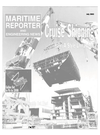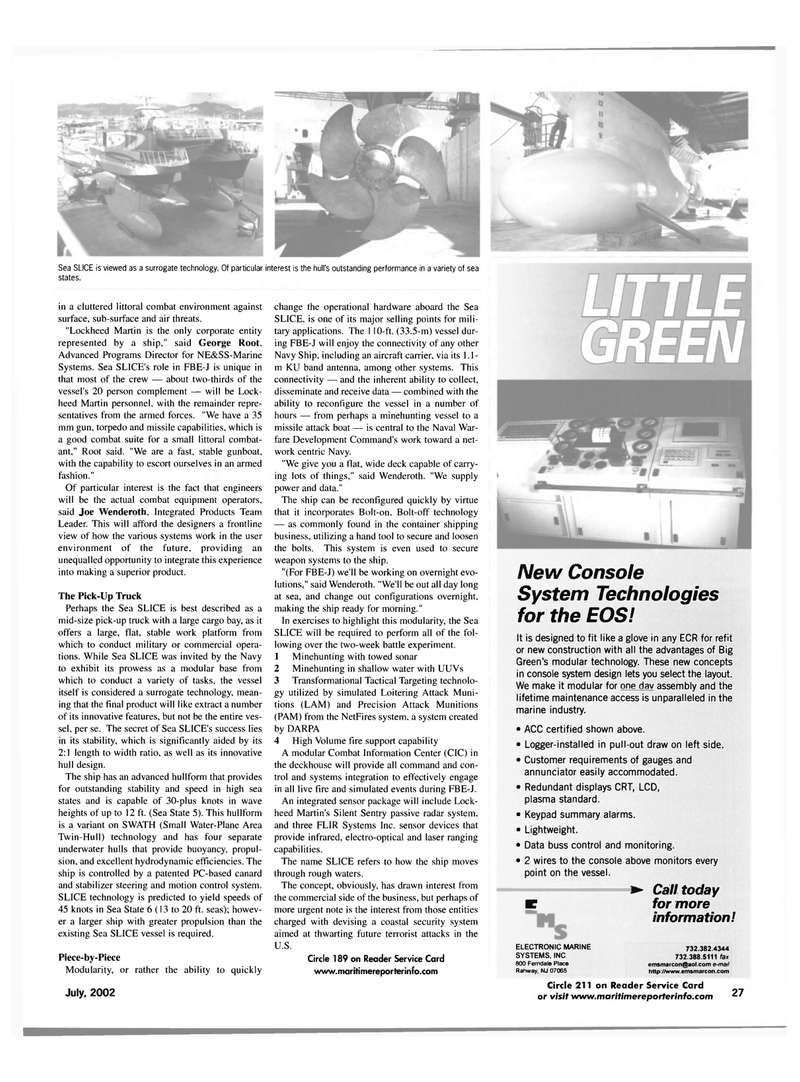
Page 27: of Maritime Reporter Magazine (July 2002)
Read this page in Pdf, Flash or Html5 edition of July 2002 Maritime Reporter Magazine
Sea SLICE is viewed as a surrogate technology. Of particular interest is the hull's outstanding performance in a variety of sea states. in a cluttered littoral combat environment against surface, sub-surface and air threats. "Lockheed Martin is the only corporate entity represented by a ship," said George Root.
Advanced Programs Director for NE&SS-Marine
Systems. Sea SLICE'S role in FBE-J is unique in that most of the crew — about two-thirds of the vessel's 20 person complement — will be Lock- heed Martin personnel, with the remainder repre- sentatives from the armed forces. "We have a 35 mm gun, torpedo and missile capabilities, which is a good combat suite for a small littoral combat- ant," Root said. "We are a fast, stable gunboat, with the capability to escort ourselves in an armed fashion."
Of particular interest is the fact that engineers will be the actual combat equipment operators, said Joe Wenderoth, Integrated Products Team
Leader. This will afford the designers a frontline view of how the various systems work in the user environment of the future, providing an unequalled opportunity to integrate this experience into making a superior product.
The Pick-Up Truck
Perhaps the Sea SLICE is best described as a mid-size pick-up truck with a large cargo bay, as it offers a large, flat, stable work platform from which to conduct military or commercial opera- tions. While Sea SLICE was invited by the Navy to exhibit its prowess as a modular base from which to conduct a variety of tasks, the vessel itself is considered a surrogate technology, mean- ing that the final product will like extract a number of its innovative features, but not be the entire ves- sel, per se. The secret of Sea SLICE'S success lies in its stability, which is significantly aided by its 2:1 length to width ratio, as well as its innovative hull design.
The ship has an advanced hullform that provides for outstanding stability and speed in high sea states and is capable of 30-plus knots in wave heights of up to 12 ft. (Sea State 5). This hullform is a variant on SWATH (Small Water-Plane Area
Twin-Hull) technology and has four separate underwater hulls that provide buoyancy, propul- sion, and excellent hydrodynamic efficiencies. The ship is controlled by a patented PC-based canard and stabilizer steering and motion control system.
SLICE technology is predicted to yield speeds of 45 knots in Sea State 6 (13 to 20 ft. seas); howev- er a larger ship with greater propulsion than the existing Sea SLICE vessel is required.
Piece-by-Piece
Modularity, or rather the ability to quickly
July, 2002 change the operational hardware aboard the Sea
SLICE, is one of its major selling points for mili- tary applications. The 110-ft. (33.5-m) vessel dur- ing FBE-J will enjoy the connectivity of any other
Navy Ship, including an aircraft carrier, via its 1.1- m KU band antenna, among other systems. This connectivity — and the inherent ability to collect, disseminate and receive data — combined with the ability to reconfigure the vessel in a number of hours — from perhaps a minehunting vessel to a missile attack boat — is central to the Naval War- fare Development Command's work toward a net- work centric Navy. "We give you a flat, wide deck capable of carry- ing lots of things," said Wenderoth. "We supply power and data."
The ship can be reconfigured quickly by virtue that it incorporates Bolt-on, Bolt-off technology — as commonly found in the container shipping business, utilizing a hand tool to secure and loosen the bolts. This system is even used to secure weapon systems to the ship. "(For FBE-J) we'll be working on overnight evo- lutions," said Wenderoth. "We'll be out all day long at sea, and change out configurations overnight, making the ship ready for morning."
In exercises to highlight this modularity, the Sea
SLICE will be required to perform all of the fol- lowing over the two-week battle experiment. 1 Minehunting with towed sonar 2 Minehunting in shallow water with UUVs 3 Transformational Tactical Targeting technolo- gy utilized by simulated Loitering Attack Muni- tions (LAM) and Precision Attack Munitions (PAM) from the NetFires system, a system created by DARPA 4 High Volume fire support capability
A modular Combat Information Center (CIC) in the deckhouse will provide all command and con- trol and systems integration to effectively engage in all live fire and simulated events during FBE-J.
An integrated sensor package will include Lock- heed Martin's Silent Sentry passive radar system, and three FLIR Systems Inc. sensor devices that provide infrared, electro-optical and laser ranging capabilities.
The name SLICE refers to how the ship moves through rough waters.
The concept, obviously, has drawn interest from the commercial side of the business, but perhaps of more urgent note is the interest from those entities charged with devising a coastal security system aimed at thwarting future terrorist attacks in the
U.S.
Circle 189 on Reader Service Card www.maritimereporterinfo.com
New Console
System Technologies for the EOS!
It is designed to fit like a glove in any ECR for refit or new construction with all the advantages of Big
Green's modular technology. These new concepts in console system design lets you select the layout.
We make it modular for one dav assembly and the lifetime maintenance access is unparalleled in the marine industry. • ACC certified shown above. • Logger-installed in pull-out draw on left side. • Customer requirements of gauges and annunciator easily accommodated. • Redundant displays CRT, LCD, plasma standard. • Keypad summary alarms. • Lightweight. • Data buss control and monitoring. • 2 wires to the console above monitors every point on the vessel. • Call today
K for more information!
ELECTRONIC MARINE
SYSTEMS, INC. 800 Ferndale Place
Rahway, NJ 07065 732.382.4344 732.388.5111 fax [email protected] e-mail http://www.emsmarcon.com
Circle 211 on Reader Service Card or visit www.maritimereporterinfo.com 27

 26
26

 28
28
